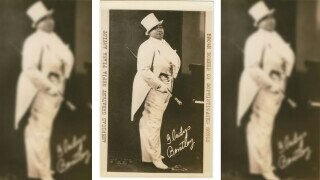Cracked Pride Month: Meet Gladys Bentley, The Badass Drag King Of The Harlem Renaissance

Grab your rainbow flags and cut those fingernails nice and short, friends! June here, meaning that pride month is officially upon us in all of its colorful, joyous, and reflective glory. In honor of this exciting occasion, Cracked will be featuring several badass LGBTQAI+ historical figures throughout the month of June, highlighting their often-overlooked albeit incredibly important impact on the world.
First up on our list of Queer trailblazers? None other than the Harlem Renaissance's finest musician, performer, and top-hat clad drag king, the incredible, openly lesbian, Gladys Bentley. Before she “thrilled and scandalized her audiences" in some of New York City's most iconic venues with her famously raunchy re-writes of popular songs, Bentley was born in Philadelphia in 1907, where she wrote about her attraction to women and appreciation for wearing men's clothing from an early age, according to Smithsonian Magazine. After moving to the big apple as a teen, where she found herself in the company of several other notably queer women, including Bessie Smith and Ethel Waters, Bentley began her career performing at underground clubs and “rent parties,” which, as the name implies, were essentially fundraiser gatherings intended up to drum up funds for rent.
As she grew more and more popular, Bentley's aspirations quickly expanded into more notable forms of nighttime entertainment, namely nightclubs. As such, the artist auditioned for The Mad House in Harlem, which was seeking a male pianist. Although she was, in fact, a woman, she was able to sway the venue's management with her astounding talent and stage presence. “At the Mad House, the boss was reluctant to give me a chance,” Bentley wrote in an article about her life for Ebony magazine, per Smithsonian. “I finally convinced him. My hands fairly flew over the keys. When I had finished my first number, the burst of applause was terrific.”
Don't Miss
Just like her impressive musical chops, Bentley's penchant for sporting dapper menswear and singing with a deep, growling voice not only earned her the classification as a drag king, but also scored points with audiences. “For the customers of the club, one of the unique things about my act was the way I dressed,” Bentley recalled in her Ebony write-up. “I wore immaculate full white dress shirts with stiff collars, small bow ties and shirts, oxfords, short Eton jackets and hair cut straight back.”
Aside from looking certifiably badass, Bentley carried her “unapologetically gay” swagger with her into her performance, frequently flirting with women in the audience, and changing the lyrics of popular tunes to be hilariously dirty, which became one of her many claims to fame.
“She quickly made a name for herself as somebody who sang ribald songs,” wrote Jim Wilson, author of Bulldaggers, Pansies, and Chocolate Babies: Performance, Race, and Sexuality in the Harlem Renaissance. “She would take popular songs of the day and just put the filthiest lyrics possible. She took the songs ‘Sweet Alice Blue Gown’ and ‘Georgia Brown,’ and combined them and it became a song about anal sex.”
As her scandalous lyrics helped her climb the ranks to New York City stardom, they also helped her garner some famous fans, including the beloved poet and Harlem Renaissance Icon, Langson Hughes, who described her as “an amazing exhibition of musical energy—a large, dark, masculine lady, whose feet pounded the floor while her fingers pounded the keyboard—a perfect piece of African sculpture, animated by her own rhythm.”
Yet just as she captured the hearts of some of New York City's finest artists, she also captured the attention of several tabloids, many of which were fascinated with her personal life. “Gladys Bentley had told the gossip columnist that she had just gotten married," Wilson recalled of the artist. “The gossip columnist asked, ‘well, who's the man?’ And she scoffed and said, ‘Man? It's a woman,’”
As the rumor mill turned, it was tough to tell truth from fiction, a testament to both the nature of tabloids and Bentley's elusive persona. “One of the frustrating and actually joyous things about Gladys Bentley was she was constantly inventing herself,” Wilson explained of Bentley's claims that she married a white woman in a same-sex civil ceremony, despite having no records proving the event. “Oftentimes when she mentioned something about her personal life, you had to take it with a grain of salt and not necessarily take it for truth," he continued.
Despite her self-assured identity throughout her time in the spotlight, Bentley ultimately denounced her lesbianism in the 1950's in an essay for Ebony entitled “I Am A Woman Again.” However, many experts who have studied her work and her life story speculate that the piece was written in response to McCarthy-era politics, which also targeted members of the LGBTQAI+ community.
Despite this change of course, Wilson says we should reflect on Bentley as the badass woman she was in her heyday – top hat and all. “Gladys Bentley should be remembered for being a gender outlaw,” Wilson wrote. “She was just defiant in who she was, and for gender and sexuality studies today, she shows the performance of gender.”
For more internet nonsense, follow Carly on Instagram @HuntressThompson_ on TikTok as @HuntressThompson_, and on Twitter @TennesAnyone.